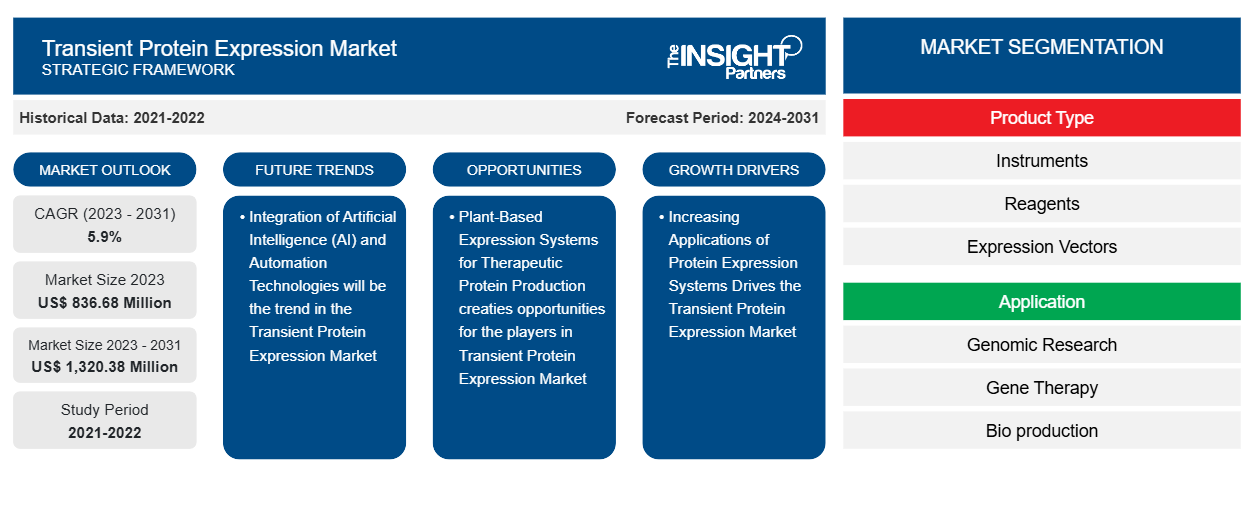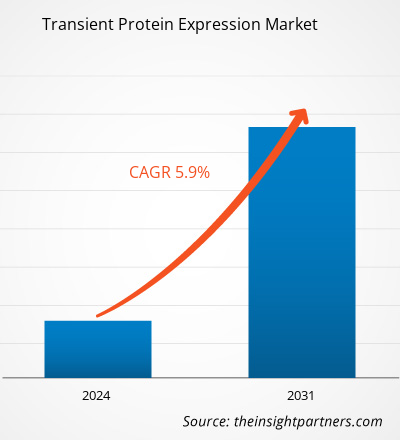The transient protein expression market size is projected to reach US$ 1,320.38 million by 2031 from US$ 836.68 million in 2023. The market is expected to register a CAGR of 5.9% during 2023–2031. Expanded application range of protein expression systems, including applications in the field of precision medicine, owing to the integration of artificial intelligence (AI) and automation technologies in protein expression workflows to enhance the efficiency, accuracy, and scalability of the overall process is likely to remain a key trend in the market.
Transient Protein Expression Market Analysis
The increasing applications of protein expression systems and the surging popularity of precision medicine are the factors favoring the transient protein expression market progress. The plant-based expression systems for therapeutic protein production are expected to fuel the market in the coming years.
Transient Protein Expression Market Overview
Animal and plant cell-based transient protein expression systems have been in use for the last three decades. Significant advancements in proteomics in recent years have resulted in the availability of newer recombinant protein varieties. The practicality and reproducibility of transient protein expression in animal and plant cells encourage research and development activities to extend their applications in human cell lines. Many contract research and development organizations as well as biopharmaceutical companies, among others, have focused their efforts on incorporating transient protein expression into their production processes. This type of expression system allows them to use different genes to create recombinant proteins without relying on the development of stable cell lines.
The temporary protein expression process finds widespread application in the manufacturing of growth factors, cytokines, hormones, blood products, modified human proteins, and monoclonal antibodies. Moreover, the creation and use of effective bioprocessing techniques have become essential for the commercial synthesis of recombinant proteins with significant therapeutic value. Recent developments in the field of bioprocessing are being applied to provide efficient methods for generating recombinant proteins. Modern Quality by Design concepts, continuous upstream processing, continuous chromatography, integrated continuous bioprocessing, high-throughput devices for efficient bioprocess optimization, disposable systems, and process analytics technologies for higher yields of high-quality products are among the recent developments that propel the adoption of transient protein expression systems.
Customize This Report To Suit Your Requirement
You will get customization on any report - free of charge - including parts of this report, or country-level analysis, Excel Data pack, as well as avail great offers and discounts for start-ups & universities
Transient Protein Expression Market: Strategic Insights

-
Get Top Key Market Trends of this report.This FREE sample will include data analysis, ranging from market trends to estimates and forecasts.
Transient Protein Expression Market Drivers and Opportunities
Surging Popularity of Precision Medicine Favors Market
With advancements in medical technologies, the use of molecular biology techniques has increased significantly in the R&D of various therapeutic or treatment modalities. Genomic transcriptomic information aids in the discovery of biomarkers that find applications in monitoring diseases and predicting their risks, serving as a key principle in different therapeutic modalities. The use of personalized or precision medicines has surged dramatically due to the availability of vast information on genetic variations existing among people. For instance, mRNA-mediated therapy is characterized by decreased immunogenicity, superior translation efficacy, enhanced stability, pharmaceutical safety, and transient protein expression, and only the modified mRNA is utilized for therapeutic application instead of incorporating the entire host genome.
Pharmaceutical and biotechnology industries have developed various innovative techniques to treat cancer and neurodegenerative diseases. Significant progress in research related to neurotrauma and neurodegenerative diseases owing to the capabilities unlocked by transient gene expression technique has resulted in the introduction of precision medicines for these conditions. Technological advancements in epigenetics, genetics, and proteomics also support the development of therapeutics for the treatment of various genetic and rare genetic diseases caused by single- and multiple-cell disorders.
Plant-Based Expression Systems for Therapeutic Protein Production in Emerging Countries to Create Market Opportunities
The use of microbial or mammalian cell-based expression systems has been a common practice in recombinant protein production processes; however, plant-based expression has been promoted as a cost-effective, scalable, safe, and sustainable alternative in recent years. Advancements in transient expression methods have resulted in a significantly shortened duration of protein synthesis and the improved yield of recombinant proteins in plant-based systems. A shift in consumer preference toward plant-based products compels pharmaceutical and biopharmaceutical companies to focus on plant-based synthesis of therapeutic proteins. The use of plants has excellent potential for improving yields of proteins that can be administered for the prevention or treatment of human and animal diseases. The use of therapeutic proteins is likely to surge in the healthcare sector in the coming years due to the ongoing restructuring of regulatory frameworks and growing awareness about transient protein expression in plants. Maximum scale‐up possibility, low growth costs, complex protein production ability, low contamination (especially involving human pathogens) risks, and optimized growth conditions are among the key advantages associated with carrying out transient protein expression in plants. Moreover, plants are considered safer compared to other expression systems as they do not produce endotoxins and cause less harm to humans. Thus, plant-based expression systems for therapeutic protein expression are emerging as vital opportunities for the transient protein expression market growth during the forecast period.
Transient Protein Expression Market Report Segmentation Analysis
Key segments that contributed to the derivation of the transient protein expression market analysis are product type, application, and end user.
- Based on product type, the transient protein expression market is segmented into instruments, reagents, expression vectors, and competent cells. The instruments segment held the largest market share in 2023.
- By application, the market is segmented into genomic research, gene therapy, bioproduction, cancer research, and drug development. The genomic research segment accounted for the largest share of the market in 2023.
- Based on end user, the transient protein expression market is segmented into pharmaceutical and biotechnology companies, academic and research institutes, and clinical research organizations. The pharmaceutical and biotechnology companies segment dominated the market in 2023.
Transient Protein Expression Market Share Analysis by Geography
The geographic scope of the transient protein expression market report is mainly divided into five regions: North America, Asia Pacific, Europe, the Middle East & Africa, and South & Central America. North America dominated the market in 2023. The North America transient protein expression market has been analyzed on the basis of the US, Canada, and Mexico. In terms of revenue, North America accounted for the largest market share in 2023. The US is the world's most important market for transient protein expression procedures and systems. The market growth in the country is attributed to extensive research and development activities in the biopharmaceuticals industry, a growing number of startups involved in protein expression, and the rising adoption of recombinant protein for therapeutic applications. In addition, the presence of various market leaders operating in the US contributes notably to the expansion of the transient protein expression market size. .
Transient Protein Expression Market Regional Insights
The regional trends and factors influencing the Transient Protein Expression Market throughout the forecast period have been thoroughly explained by the analysts at The Insight Partners. This section also discusses Transient Protein Expression Market segments and geography across North America, Europe, Asia Pacific, Middle East and Africa, and South and Central America.
Transient Protein Expression Market Report Scope
| Report Attribute | Details |
|---|---|
| Market size in 2023 | US$ 836.68 Million |
| Market Size by 2031 | US$ 1,320.38 Million |
| Global CAGR (2023 - 2031) | 5.9% |
| Historical Data | 2021-2022 |
| Forecast period | 2024-2031 |
| Segments Covered |
By Product Type
|
| Regions and Countries Covered |
North America
|
| Market leaders and key company profiles |
|
Transient Protein Expression Market Players Density: Understanding Its Impact on Business Dynamics
The Transient Protein Expression Market is growing rapidly, driven by increasing end-user demand due to factors such as evolving consumer preferences, technological advancements, and greater awareness of the product's benefits. As demand rises, businesses are expanding their offerings, innovating to meet consumer needs, and capitalizing on emerging trends, which further fuels market growth.

- Get the Transient Protein Expression Market top key players overview
Transient Protein Expression Market News and Recent Developments
The transient protein expression market is evaluated by gathering qualitative and quantitative data post primary and secondary research, which includes important corporate publications, association data, and databases. A few of the developments in the transient protein expression market are listed below:
- Merck, a leading science and technology company, was granted its second patent for CRISPR-chrom technology. With this, the company became the only provider with a patent covering the fusion of chromatin-modulating peptides to CRISPR proteins, helping to clear chromatin out of the way, enhancing access to the genome. [Source: Merck, Company Website, February 2020]
Transient Protein Expression Market Report Coverage and Deliverables
The "Transient Protein Expression Market Size and Forecast (2021–2031)" report provides a detailed analysis of the market covering below areas:
- Transient protein expression market size and forecast at global, regional, and country levels for all the key market segments covered under the scope
- Transient protein expression market trends as well as market dynamics such as drivers, restraints, and key opportunities
- Detailed PEST/Porter's Five Forces and SWOT analysis
- Transient protein expression market analysis covering key market trends, global and regional framework, major players, regulations, and recent market developments
- Industry landscape and competition analysis covering market concentration, heat map analysis, prominent players, and recent developments for the transient protein expression market
- Detailed company profiles
Frequently Asked Questions
Which region dominated the transient protein expression market in 2023?
What are the driving factors impacting the transient protein expression market?
Which are the leading players operating in the transient protein expression market?
What would be the estimated value of the transient protein expression market by 2031?
What is the expected CAGR of the transient protein expression market?
- Historical Analysis (2 Years), Base Year, Forecast (7 Years) with CAGR
- PEST and SWOT Analysis
- Market Size Value / Volume - Global, Regional, Country
- Industry and Competitive Landscape
- Excel Dataset
Recent Reports
Testimonials
Reason to Buy
- Informed Decision-Making
- Understanding Market Dynamics
- Competitive Analysis
- Identifying Emerging Markets
- Customer Insights
- Market Forecasts
- Risk Mitigation
- Boosting Operational Efficiency
- Strategic Planning
- Investment Justification
- Tracking Industry Innovations
- Aligning with Regulatory Trends





















 Get Free Sample For
Get Free Sample For